Korean Food 101: An Underappreciated Food Delivery Option
Posted by Sara on Thursday, May 15th, 2014 with 5 Comments
Why are so many offices stuck in a pizza-and-Chinese-takeout rut? Partly because those two cuisines are delicious, but partly because they’re familiar crowd-pleasers: chances are, even the least adventurous eater in the office grew up eating pizza and Chinese food. And while it can be awkward to ask your coworker who always orders plain cheese pizza or sweet and sour chicken to try something new, it can also be incredibly rewarding.
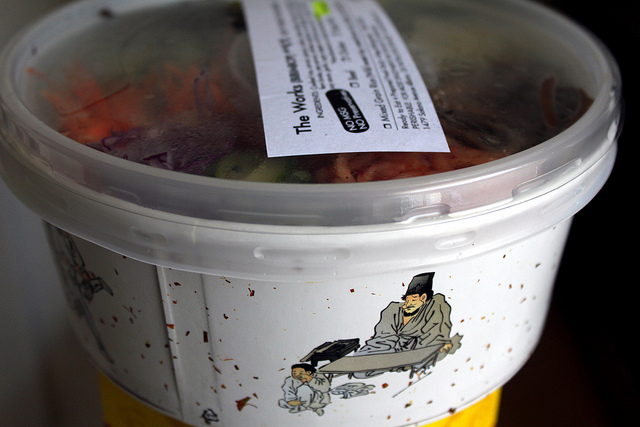
Liven up your office lunch routine with Korean food delivery.
Image source: Flickr user Quinn Dombrowski
For companies that believe sharing meals can bolster teamwork and morale in the workplace, there’s something really special about gathering your coworkers around the lunch table to try a new cuisine together. Korean food is the perfect example. It’s at least vaguely familiar (mostly thanks to the now-ubiquitous Korean taco trucks in many cities), but since most of us didn’t grow up eating the cuisine, Korean dishes can lend an adventurous vibe to an otherwise typical workday lunch shared with colleagues.
Best of all, Korean food offers a wide range of options for all kinds of diners: there are flavorful, but straightforward beef dishes that are great for pickier eaters, along with spicier and fermented foods for those who want to embrace the full experience of Korean cuisine. With both needs in mind, here’s our beginners’ guide to Korean takeout and food delivery:
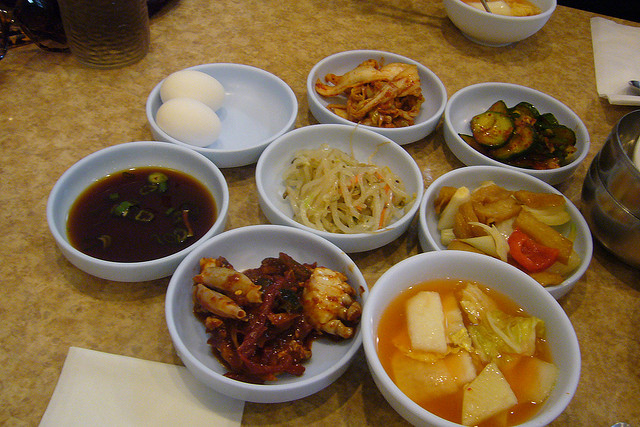
Banchan is a spread of complimentary side dishes at Korean restaurants.
Image source: Flickr user Kent Wang
Banchan
When you visit a Korean restaurant, the first thing you’ll eat will likely be banchan: a spread of complimentary appetizers that will simply show up at your table. The individual dishes will be different depending on the restaurant, but frequent players include namul (vegetables) like bean sprouts, spinach, and radishes, often stir-fried with garlic and chiles, kimchi (more on that below), and jeon, little savory pancakes made with assorted meats or vegetables, eggs, and rice flour. Even when you order food delivery from a Korean restaurant instead of dining in, you may find some banchan included in your takeout bag.
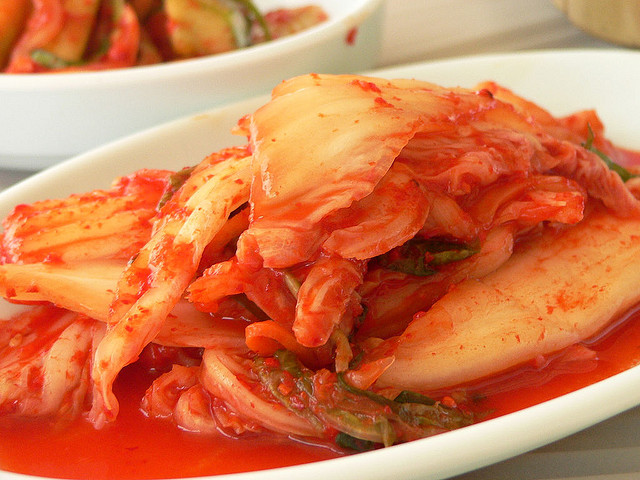
Kimchi is a hot, sour, utterly delicious mixture of fermented cabbage and other veggies.
Image source: Flickr user Craig Nagy
Kimchi
Kimchi is perhaps the most famous Korean dish, and is included with most meals; it’s used as a side dish and as a condiment mixed in with entrées. Imagine fermented pickles, if you can, but made with cabbage and spices instead of cucumbers. Kimchi can be made very fiery or quite mild, but in most cases it will be a little sour, a little hot, and a little pungent — although there are more than 100 variations of kimchi available, so you’ll learn to taste a little bit before adding it into your meal.
Gochujang
Another condiment and almost as ubiquitous in Korean food as kimchi, gochujang is a spicy sauce made from fermented red chiles. Adventurous eaters will love gochujang, but those who don’t like spicy foods should request dishes with only a small amount.
Bibimbap
Bibimbap may be the perfect choice for a Korean lunch. It literally means “mixed rice”, and is a bowl of white rice stir-fried with assorted ingredients, like vegetables, sliced meat, and occasionally an egg. The dish is served with its components piled together in a bowl, and then you add your desired amount of sauce and mix everything together. Bibimbap is easy to order with ingredients you like (beef, pork, chicken) and usually served with gochujang on the side, so it’s a little more amenable to diners who want to control the spiciness of their food, and probably the best dish for picky eaters to try.
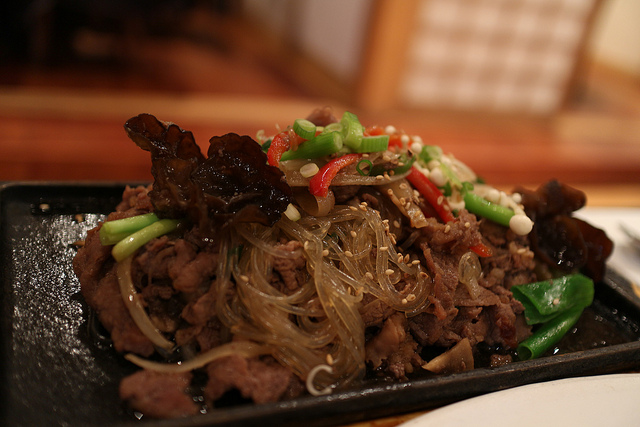
Bulgogi literally means grilled meat, and this is a delectable plate of beef bulgogi.
Image source: Flickr user Elsie Hui
Bulgogi
Bulgogi means “grilled meat” (commonly referred to as Korean barbecue) and is most famously made with beef — although it can also be pork, chicken, or other meats. Bulgogi generally consists of thinly sliced meat marinated in ginger, sugar, soy sauce, and other spices, then grilled. Tender, juicy, and packed full of flavor without being too fiery, bulgogi is an excellent dish for meat lovers and usually served with a bowl of rice and some vegetables. Another delicious variation is galbi, marinated and grilled boneless short ribs.
Jjigae
Light, spicy stews called jjigae are another staple of Korean restaurants, and come in many variations. Some of the most popular are the self-explanatory kimchi jjigae, sundubu jjigae (made with tofu), and doenjang jjigae (made with doenjang, a popular condiment made from soybean paste, and usually combined with vegetables and tofu).
While there are dozens of Korean dishes to explore, these are the most popular (and some of the most approachable) meals to add to your next food delivery order. When you’re ready to begin your exploration of Korean cuisine, you’ll find plenty of menus and easy online ordering available at Waiter.com!
When it comes to feeding employees and coworkers, make your company's food program really count! If your workplace dining plan needs to take it up a notch — or if you don't have one at all — Waiter.com is here to help. From Virtual Cafeteria Service to diverse menus to local takeout & delivery, Waiter.com offers customizable dining solutions for every business and budget. Contact us today to get started!
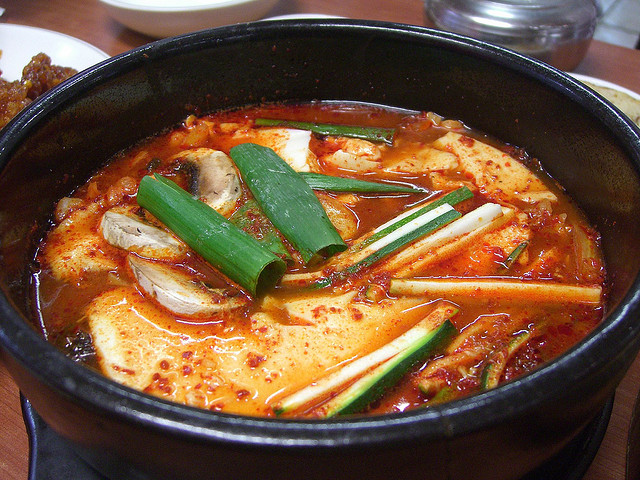

I absolutely love this idea. I work in an environment of not very adventurous eaters and I KNOW everyone loves Korean BBQ. Its ubiquitously delicious to all. This article is a good beginner’s guide to typical Korean dishes. I am concerned about the integrity of Jjigaes for deliveries since it can be messy and the whole point is to eat it out of the stone pot. Bulgogis and bibimaps are great ideas for an office catering event.
Thanks Lin! While it’s true the takeout experience is different than dining in a restaurant, there are definitely options out there that are clean and convenient – as you mentioned it, bulgogi and bibimbaps especially would be perfect for office catering!
Nice post and nice pics. I’m not very familiar with Korean food other than Kimchi which I like a lot. I am however an adventurous eater and will try most things once – as long as they look and smell good. With that said, the jjigae looks good. I like tofu and I wonder if there’s a fish option. I’ve shared many take out lunches – and dinners on the job. Agreed – pizza and Chinese are the usual standbys with Mexican running a close third on my workplace anyway. For the most part my co-workers are open minded as long as the food is tasty. Majority rules of course and I don’t know if we have a Korean restaurant nearby, but this has me thinking I should try Korean next time someone mentions ordering a pizza.
Thanks! Majority does rule, but remember – it only takes one awesome experience for a cuisine to become the new favorite food in the office!
This article made me want to reconsider my usual workplace food choices. I used to sort of lump all oriental food together, but some of these Korean dishes look intensely delicious. Here’s the thing: Chinese food, especially the containers it comes in, is extremely portable and mess-free. I would want to be sure my food arrives as it’s meant to, and is easy to eat. I know a restaurant is quickly vetoed by my coworkers if the food is frequently messy or not easy to save. Though I really like the Korean food idea.